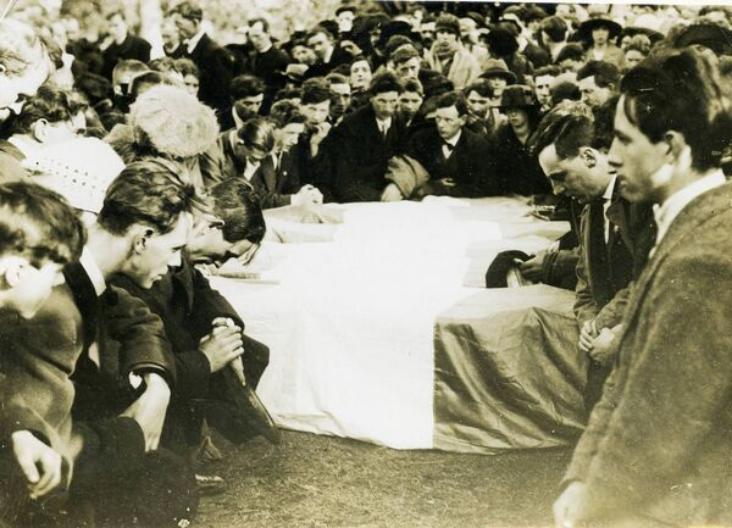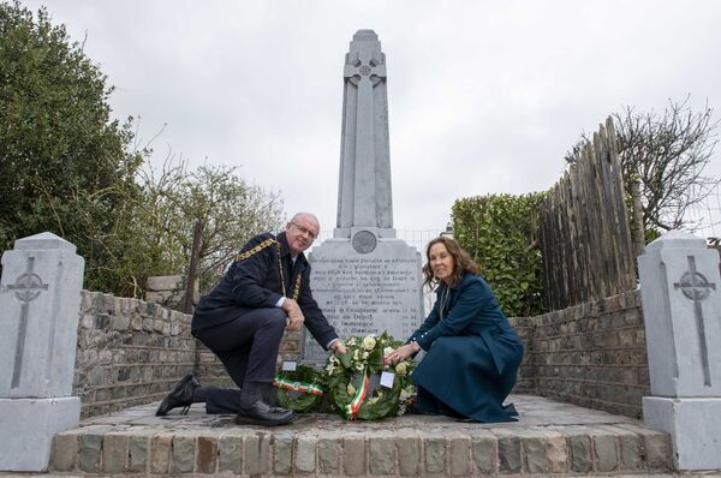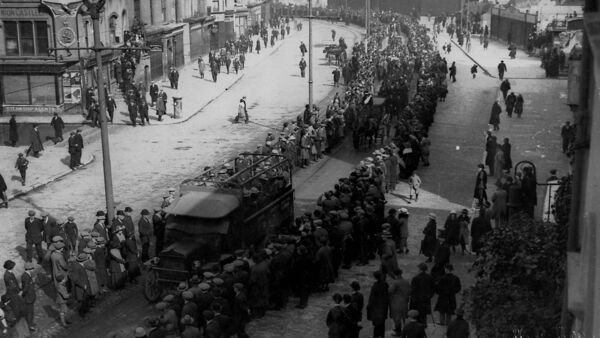HE next-door neighbours were far from neighbourly. In fact, the relationship between the O’Connors and the Deasys often amounted to a feud at 50 yards — the distance between their cottages in Mount Desert, on the edge of Cork.
How it all began is uncertain, but we know how matters ended — with the Deasys mourning their son Willie, killed in a 1921 police raid in nearby Ballycannon, along with five other local members of the Irish Republican Army. And the O’Connors wound up exiled to America, their son Paddy stalked through three nations by relentless IRA avengers who finally gunned him down in New York in 1922.
It was Paddy, you see, who got Willie and the other men killed on Kerry Pike in Ballycannon.
Their two families had been at it since at least 1895, when the head of the Deasy clan, William, was charged with trying to break into the O’Connor home (the name was often shortened to Connors). Four years later, they were all back in the court, with Deasy describing a dispute between the families. In 1908, William Deasy accused Paddy’s father, John, of slamming him over the head with a blunt instrument.
It was the flat of my hand, O’Connor replied.
Despite the feud, the families sometimes cooperated. In 1899, just months before their husbands landed in Blarney petty sessions, the two wives were desperately trying to save the life of young Eliza Deasy. A bedtime accident with a candle had set her ablaze, and Hannah O’Connor rushed over to help, applying balm. Then she helped move the girl to the hospital, where Eliza died the next day.
By 1920, the two neighbour boys, Willie Deasy and Paddy O’Connor, were now comrades in the IRA, members of C Company, 1st Battalion, on the western fringe of Cork, where Blarney Road bleeds into the fields of Clogheen north of the River Lee.
Willie had been a member of the Volunteers since at least April 1918. Paddy joined later, as the War for Independence from Britain was heating up.
In one of his first recorded actions, in December 1920, O’Connor executed a suspected spy. It must have been a wrenching experience, for O’Connor had a secret — he himself had been a paid spy for the crown, earning two pounds 10 a week. But after joining the IRA, he “ceased to provide information,” according to a British army report.
The situation in Cork that December was dire — the city centre had been torched by members of the Auxiliary Division of the RIC. Crown forces regularly raided the homes of IRA members. It was time for O’Connor and several active members of C Company — Willie Deasy, Jeremiah Mullane, and Patrick A “Pa” Murray among them — to get out of town. They headed to Ballyvourney, where the IRA’s Cork No. 1 Brigade flying column was being formed.
This may well be when O’Connor got his enduring nickname: Cruxy.
There are two theories about its origin. One holds that he won the Croix de Guerre as a British army sergeant-major in the First World War. But there are no records of him in the military, and his family says he never served in the war. Other accounts say O’Connor’s comrades mockingly tagged “Cruxy” because he boasted that he’d won the medal, mispronouncing it as “Crux na Gurra”. In Ballyvourney about 60 IRA men drilled and trained, and the country boys cast a cold eye on O’Connor, who liked to ask questions and jot things down nightly in a diary. “Over-inquisitive” was the word that came to mind for one IRA man.
Soon it was time to go to war.
The ambush site lay at a crossroads on the Macroom-Killarney Road, in an area variously identified as Coolavokig, Paulnabro and, in the local tradition, as Coolnacaheragh. A convoy of Auxiliaries would be approaching from Macroom in the east. Two machine guns were placed at either end of the quarter-mile-long ambush site — steel jaws that would snap shut, pinning the convoy while rebel riflemen along the road raked it with volleys. O’Connor was given a crucial job: manning the eastern machine gun.
For days that February, the column waited in the rocky outcrops and damp fields for the Auxiliaries. The harsh conditions took a toll on the city men — Pa Murray, Willie Deasy, and Jerry Mullane were all pulled back.
On the morning of Friday, February 25, a convoy carrying an estimated 50 Auxiliaries finally showed up, an hour early, and with a nasty surprise — civilian hostages they carried as human shields. The vehicles advanced slowly, because they had heard of the ambush, and then spotted an out-of-position IRA man dash across the road. The convoy had not fully entered the ambush zone when the shooting began.
The British commander Major James Seafield Grant was killed early on, and the Auxiliaries retreated toward two cottages alongside the road. O’Connor fired a burst from the Lewis gun, but then it fell silent — he claimed that it jammed. In fact, all along the line, IRA gunfire slackened because the Auxiliaries and the hostages were jumbled together in a scramble for cover, while IRA riflemen redeployed to cover the Auxiliaries' unexpected position.

Mourners pray over the coffins of the IRA volunteers killed in the Clogheen Ambush. Picture: Courtesy National Museum of Ireland
The siege of the cottages went on for hours, and much of the action took place right in front of O’Connor’s position — the Lewis gun could have been devastating. But it stayed silent, and eventually British reinforcements arrived.
The flying column pulled out without loss, and evaded an attempted British round-up. They had killed three police and wounded 10 more, without suffering any losses. However, many column members were bitter that the Coolnacaheragh ambush wasn’t a bigger success. Some blamed O’Connor.
“He fired a few rounds and then abandoned the gun, falsely stating that it was jammed,” one complained. “It lay idle for the rest of the fight.” Cruxy returned in disgrace to Cork, where just weeks later the police caught him with a gun.
Facing execution in a city under martial law, O’Connor switched sides again, claiming to be a British secret agent. His old spymaster denied it, and with the threat of a firing squad hanging over his head, Cruxy broke down after hours of interrogation. As Willie Deasy’s brother, Jerry, put it: “He was a rather unstable, emotional type and, no doubt, could not take the treatment.”
O’Connor gave away a lot of information, including the location of a hideout at a farm on Kerry Pike. The police raided the Ballycannon farm on March 23, 1921. It was Wednesday of Holy Week — or Spy Wednesday, for the day that Judas betrayed Jesus.
Six men of O’Connor’s comrades from C Company had bedded down at the farm. At least two had served with Cruxy in the flying column —Willie Deasy, his neighbour; and Jeremiah Mullane, along with Dan Crowley, Tom Dennehy, Mick O’Sullivan, and Danny Murphy. Caught unaware, they never had a chance.
Neighbours heard cries of “run for it” then volleys of gunfire. All six men died riddled with bullets.

The Lord Mayor of Cork, Cllr Joe Kavanagh, accompanied by his wife Stephanie, recently placed a wreath at the monument at Ballycannon, Clogheen commemorating the six men who were shot by the Black and Tans on the night of March 22, 1921. Picture: Brian Lougheed
As a grieving Cork prepared a funeral for the six “Ballycannon Boys” on Easter Sunday, the fifth anniversary of the Easter Rising, Cork IRA commanders learned that O’Connor had talked. On Easter, a long funeral cortege wound through Cork to the cathedral, under the nervous eyes of the British army.
As Cork mourned, the IRA sought to arrange one more funeral: Cruxy’s. It sent a woman disguised as his mother to bring him a poisoned meal at the Victoria Barracks. That failed when his real mother showed up at the barracks moments later — Mrs O’Connor proved too much to handle for the IRA squad detaining her during the operation.
An attempt to track O’Connor down in London also failed — he knew he was being stalked, and sailed for America. It was there, in New York, that three gunmen from C Company — Pa Murray, Danny Healy and Martin Donovan — finally caught up with Cruxy, in what appears to be the IRA’s only authorised attack on American soil.
On the evening of April 13, 1922, O’Connor left his apartment on the Upper West Side for a walk along nearby Central Park. Healy was waiting near 84th Street.
He stepped from behind a tree, said something like “Got you,” and fired. O’Connor dashed into the intersection and ducked around a trolley, as Healy followed, firing.
Finally, Cruxy went down, and Healy shot him twice more, then made his getaway. O’Connor, hit five times, was rushed to a hospital.
Decades later, Healy noted the significance of the timing: “It was Holy Thursday night, 1922, and almost a year exactly since the Ballycannon murders.”
Incredibly, O’Connor managed to recover from his wounds. He moved to Canada, married an Irish immigrant and had a daughter. He died in 1952, at age 60.
For some relatives of the Ballycannon boys, there was no recovering.
The shock of the massacre left Michael O’Sullivan’s sister hospitalised for months — she never worked again. Jeremiah Mullane’s father had to give up his job, too, and took to bed, ill and dispirited. He died in 1924.
Dan Healy, Pa Murray and Martin Donovan made it back to Cork, possibly aided in their escape by one more change of heart from the mercurial O’Connor. Fading in and out of consciousness after the ambush, the wounded man refused to tell the New York City police detectives who had shot him, though he certainly knew.
Then and later, whenever asked, Cruxy would resolutely shake his head.
And so the spy who stopped spying and the gunman who stopped shooting became the informer who stopped informing.
DESPITE the “deplorable actions” of a spy who abandoned his key position in charge of an IRA machine-gun, the ambush at Coolnacaheragh succeeded in forcing a change in British strategy and was a factor in achieving the Truce of 1921.
The ambush of a convoy of Auxiliaries travelling from Macroom on February 25, 1921, was led by Seán O’Hegarty and involved the 1st Cork’s Flying Column, with volunteers from companies across mid-Cork.
Auxiliary commandant major James Seafield-Grant, who led the convoy, was killed early in the four-hour engagement. RIC constable Arthur Cane later died of injuries received, as did Lieutenant Cleve/Clive Soady, who was shot in the mouth, and whose grave is at Macroom’s Protestant churchyard, one of the few non-Irish Auxiliaries to be buried in Ireland.
There are conflicting reports as to the numbers of dead and wounded, with 10 members of the Auxiliary Division later making compensation claims, while a republican monument at the site puts British casualties at 28. The IRA reported no casualties. A century after the ambush, no official British casualty figures have yet been released.
Much of the action took place in two cottages at the eastern edge of the Coolnacaheragh ambush site in which Auxiliaries came under siege from IRA fire.
The Auxiliaries had taken cover in the cottages, beside the Cork-Killarney road, making “loopholes” in the walls, through which to fire their guns.
Once inside, they came under further IRA fire, the steps to one of the houses reportedly “covered in blood that flowed from the cottage”.
Lieutenant Cleve Soady is believed to have been mortally wounded in this cottage.

The monument to the ambush at Coolnacaheragh near Baile Mhúirne
The occupants of the two cottages, the Twomey and Cronin families, were told to leave their homes under cover of darkness before the ambush began, on February 25. Gerard Lynch’s grandparents, Hannah and Patrick Cronin, were living with Hannah’s elderly father Diarmuid Kelleher and their three young daughters, in the cottage that saw most of the action.
“What I know from my mother and my aunt was that coming up to the time of the ambush they were tipped off by the ‘boys’ that the ambush was going to happen but they were sworn to absolute secrecy.
“They could only leave the house in the dead of night because if there was any unusual activity it could tip off the British forces. So my granduncle from Cill na Martra borrowed a horse and cart and came to Coolnacaheragh and moved my grandparents and their three children and my great grandfather, Diarmuid Kelleher, over to Dundareirke [Cill na Martra], which was my grandfather’s homeplace,” said Mr Lynch.
His great grandfather, then in his early 80s, “was bedridden and they had to take a door off downstairs and put him on the door to bring him down the stairs and put him on the cart in the middle of the night”, said Mr Lynch.
During the ambush, he said, “the British retreated back to the cottage and dragged their injured in there”.
“Most of them were trapped under fire inside the cottage that I was born into. There were four steps from the door of the cottage to the road and it was said that the steps were covered in blood that flowed from the cottage. There were so many injured in the cottage that the blood was running out the door and along the steps and out onto the road.”
Both cottages, along with several neighbouring outbuildings, were subsequently burned by the Auxiliaries, whose retaliation for Coolnacaheragh also included the wounding of volunteer Jeremiah Lucey in Baile Mhúirne, the shooting of livestock, and a donkey being “used for bayonet practice”.
Mr Lynch’s grandparents and their family were to spend the next six years living with their in-laws in Cill na Martra before their house was repaired under a government scheme. The house, he said, had been “burned in retaliation” but in reality his family had little choice but to leave their home. “It was thought at the time that the occupants of the cottages were in cahoots with the ambush, but to stay would have been to have been slaughtered,” he said.
He recalls also an event that occurred 40 years after the ambush, when his mother Pauline received a surprise visitor to her home in Coolnacaheragh.
“Major Seafield-Grant, who was killed in the ambush, had a three-year-old son at the time that he died, and that son visited Coolnacaheragh in 1964-65 and called to my mother,” he said. “He was looking for the actual spot where his father had been killed. My mother showed him as best she could and then she realised who he was and he actually came in and had tea in the cottage.
“She always thought it was very sad on a human level that a three-year-old child was left without his father, and I think he was his only child.”
- Mark Bulik is a journalist in New York and the author of The Sons of Molly Maguire: The Irish Roots of America’s First Labor War. He is currently working on a history of Cruxy O’Connor, the Ballycannon boys and the New York ambush. He can be reached at: markbulik@verizon.net -
This article was first published in the Irish Examiner on 25 March 2021




